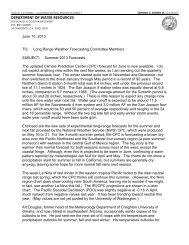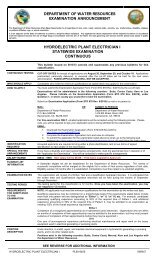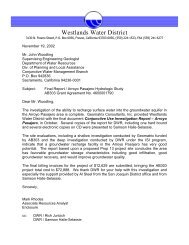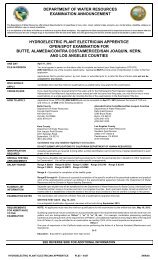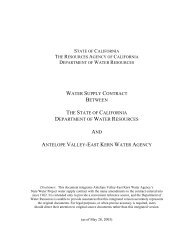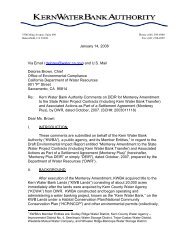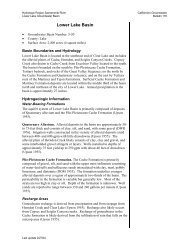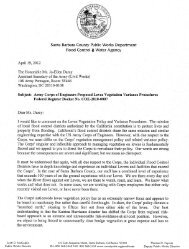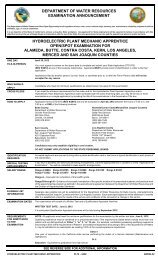Bulletin 1.pdf - California Department of Water Resources - State of ...
Bulletin 1.pdf - California Department of Water Resources - State of ...
Bulletin 1.pdf - California Department of Water Resources - State of ...
You also want an ePaper? Increase the reach of your titles
YUMPU automatically turns print PDFs into web optimized ePapers that Google loves.
WATER RESOURCES OF CALIFORNIA 41<br />
areas. It occurs principally in the desert regions, especially in the<br />
Lahontan and Colorado Desert Areas and in adjacent portions <strong>of</strong> the<br />
Central Valley and South Coastal Areas. Analyses <strong>of</strong> floods caused by<br />
cloudbursts are not included in this bulletin, since sufficient data with<br />
reference to areal extent and frequency <strong>of</strong> occurrence are not available.<br />
Those rainstorms in <strong>California</strong> which produce floods not associated<br />
with cloudbursts are general and cover large areas. In nearly all cases<br />
they occur during winter and early spring, and may last several days,<br />
although periods <strong>of</strong> intense rainfall are comparatively short. While<br />
general storms are common during the rainy season, destructive floods<br />
are only infrequently produced. To cause a major flood the storm must<br />
either be <strong>of</strong> long duration, or must occur while watersheds are saturated<br />
and little channel storage space is available. The combination <strong>of</strong> a<br />
saturated watershed and such a storm is rare.<br />
Estimated magnitudes <strong>of</strong> mean daily flows <strong>of</strong> rainwater floods with<br />
probable frequencies <strong>of</strong> once in 100 years and once in 250 years on seven<br />
representative streams in the <strong>State</strong> are given in Table 5. This table also<br />
shows maximum instantaneous recorded flows on these streams, including<br />
preliminary estimates for the floods <strong>of</strong> November, 1950, where applicable.<br />
No estimates are given for streams in the Colorado Desert Area, as :floods<br />
in this Area are mainly <strong>of</strong> the cloudburst type.<br />
Snowfloods<br />
Floods resulting from melting snow occur in streams that drain the<br />
higher mountains <strong>of</strong> the <strong>State</strong>, and characteristically have longer duration<br />
and lower peak :flows than rainwater floods. Data relating to daily<br />
flow for one, two, three, five or even ten days have little significance in<br />
these floods. In the present investigation snow-melt season from April<br />
to July, inclusive, has been considered as one :flood period, and total<br />
volume <strong>of</strong> flow has been computed for these four months. Volumes <strong>of</strong><br />
BIlOW melt were determined for those 13 streams <strong>of</strong> the Sierra Nevada on<br />
which have occurred the greatest snow-melt :floods experienced in the <br />
<strong>State</strong>. Nine <strong>of</strong> the streams are in San Joaquin Valley in the Central Valley<br />
Area, and four are in the Lahontan Area. Estimates <strong>of</strong> volumes <strong>of</strong> snow<br />
floods with probable frequencies <strong>of</strong> once in 100 years and once in 250<br />
years are shown in Table 5, for two <strong>of</strong> the representative streams <strong>of</strong><br />
<strong>California</strong>.<br />
QUAUTY OF WATER<br />
Most fresh waters in <strong>California</strong> are <strong>of</strong> excellent quality and well<br />
suited to irrigation and other beneficial uses. This is especially true <strong>of</strong><br />
drainage from the North Coastal Area and from the eastern side <strong>of</strong> the<br />
Central Valley Area, both <strong>of</strong> which Areas have large watersheds with<br />
high water yield. Analyses show that their surface and underground<br />
waters possess remarkably slight concentrations <strong>of</strong> salts, low percent<br />
sodium, and relatively small amounts <strong>of</strong> elemental boron. These waters<br />
are <strong>of</strong> the bicarbonate type, and calcium is the predominating base. Surface<br />
waters <strong>of</strong> comparatively high salinity are found in streams on the<br />
west Bide <strong>of</strong> the San Joaquin Valley, in Cache Creek in the Sacramento<br />
Valley, in basins on the west slope <strong>of</strong> the Diablo Range that separates<br />
the Central Coastal and Central Valley Areas, in Cuyama and Santa<br />
Maria Rivers in the Central Coastal Area, and in Piru and Sespe Creeks



